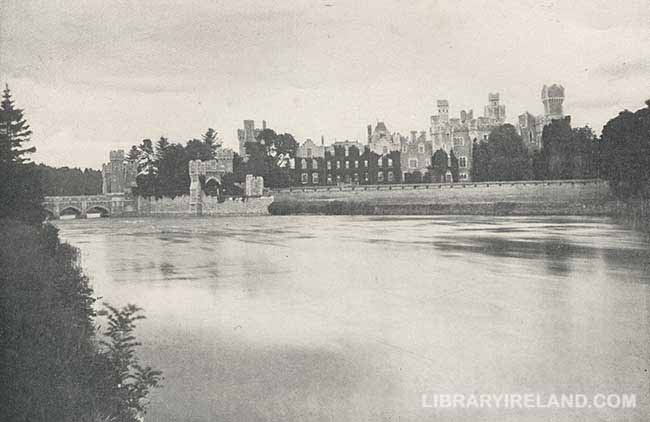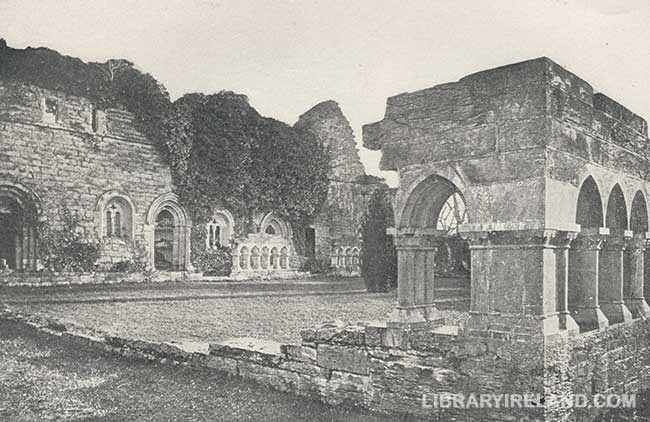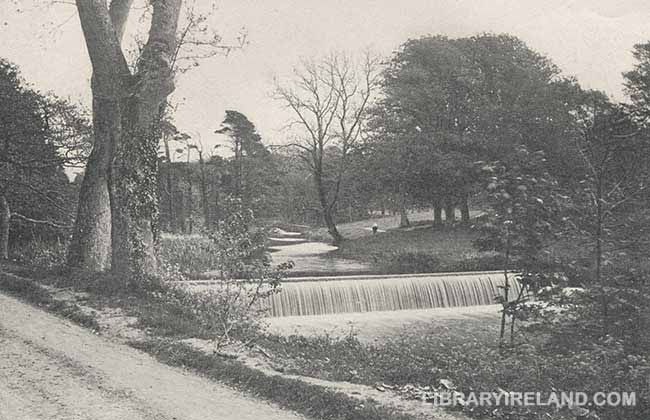Ballinrobe to Leenane
OUR next points were Claremorris and Ballinrobe. They were not interesting, so we took a car to Cong, a very ancient place lying on the neck of land which separates Lough Corrib from Lough Mask. St. Fechin, of Fore, founded a church here in 624, and it is at this place that Lord Ardilaun has his castle, a large building on the shores of Lough Corrib, surrounded by an immense park, with fine timber, Italian sunken gardens, and a pheasantry. In the gardens, in luxuriant profusion, countless varieties of rare plants, gigantic palms, delicate ferns, are as much at home as in their native tropics, carefully nurtured in a climate tempered to their necessities, soft and balmy from the influence of the Gulf Stream.

Lord Ardilaun's Castle and Demesne, Cong, County Mayo
Lord Ardilaun has many other attractions besides these at Ashford Castle—i.e., steam-yachts, watch-towers, conservatories, stables, a salmon-river, game-preserves, and large herds of red and fallow deer, not to mention the Augustinian monastery built by the king-monk Roderic O'Conor in the twelfth century. He was the last Irish king, and lived the concluding fifteen years of his life within these walls as a monk, in the strictest seclusion; he died in 1198, aged eighty-two.

Cong Abbey, County Mayo
The Cross of Cong, which was made for Tuam, was brought here, it is thought, by Roderic O'Conor. It measures two and a half feet high, one foot six and three-quarter inches across arms, and one and three-quarter inches thick. It is made of oak plated with copper, and covered with the most beautiful gold tracery of Celtic pattern. In the centre of the arms is a large crystal; thirteen of the original eighteen jewels remain, set along the edges of shaft and arms, while eleven of those which were set down the centre of arms and shaft and round the crystal are lost. It was found by the Rev. P. Prendergast early in the present century in a chest in the village, and after his death it was purchased by Professor MacCullagh for one hundred guineas, and presented to the Royal Irish Academy.
Loughs Mask and Corrib are connected by an underground river, as the porous nature of the rock will not permit the water to flow on the surface. We went down thirty feet into the "pigeon-hole," which is near the castle, to see the flow of water through the ground. The arrangements for seeing this place might truly be called hospitality in a high form, as everything is shown and nothing expected in return for the courtesy. The solicitude of the old gate-keeper for our welfare was particularly marked, for when we returned to the gate after a very peaceful inspection, he doffed his hat and exclaimed, "Glory be to God, yer honors have returned safe and in good health, too, I see!"

Water-fall in the Marquis of Sligo's Demesne, Wesport, County Mayo
During the Irish famine an attempt was made to dig a canal connecting the lakes, so as to give the people something to do, and an enormous amount of money was sunk in the project. The rocky bed absorbed the water, however, as fast as it flowed in, and the enterprise proved an utter failure. Every visitor asks what it is when he sees it. It is called "The Great Blunder."
Read "On an Irish Jaunting Car through Donegal and Connemara" at your leisure
Read On an Irish jaunting Car through Donegal and Connemara at your leisure and help support this free Irish library.
Samuel Gamble Bayne was born in Ramelton, County Donegal, and educated at Queen's University in Belfast. At the age of twenty-five he left for America with a view to making his fortune. He invested in an oil well in Pennsylvania and later founded a bank which subsequently came to be the JP Morgan Chase bank in New York. By the time this book was written he was wealthy enough to be referred to as a billionaire. His account of the tour through the north, west and south of Ireland is a pleasant snapshot of how that part of the country was in the early part of the 20th century. He describes what is to be seen, gives some background history and, through the illustrations especially, provides wonderful glimpses of the area's social history.
The ebook is available in .mobi, .epub, and .pdf formats. See details ».

